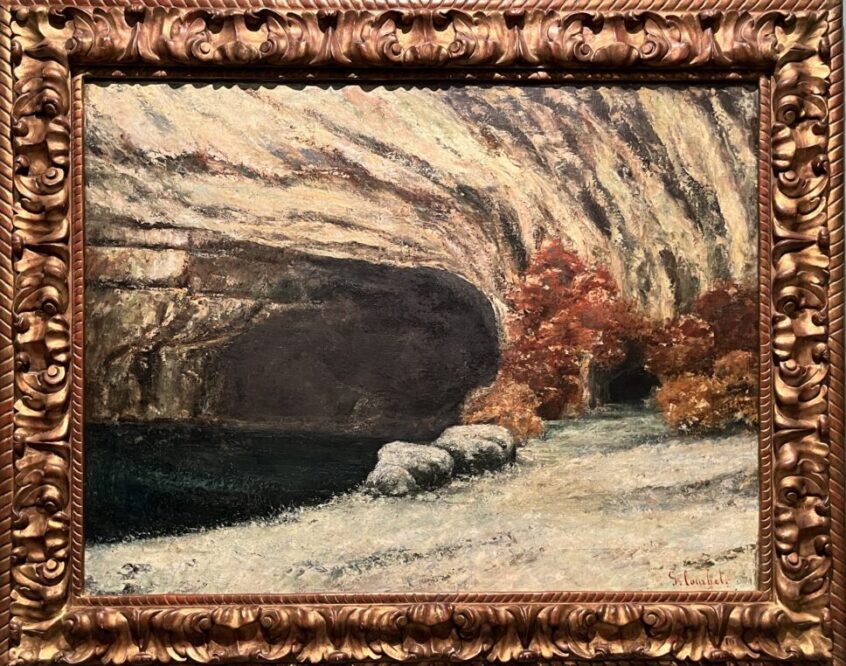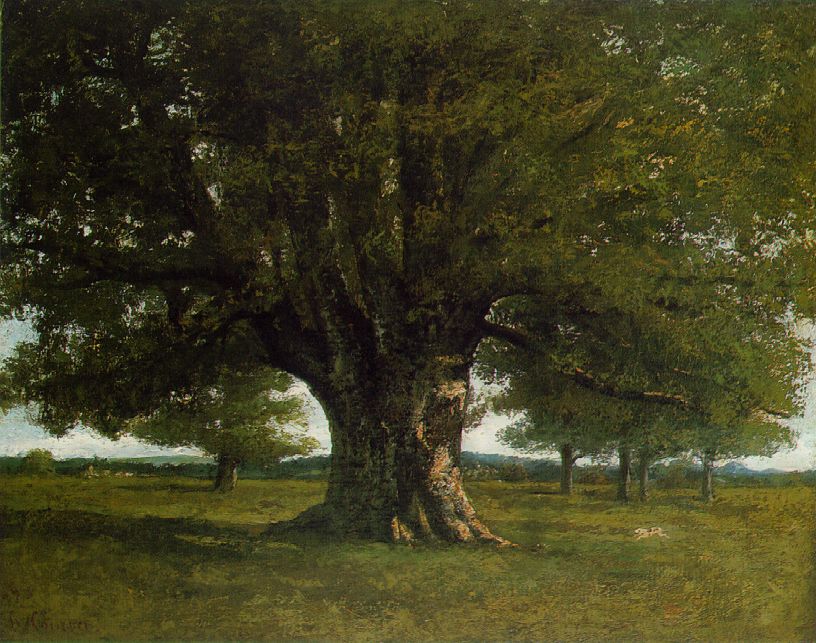
A view of the Museum in Ornans on the river Loue © musée départemental Gustave Courbet, photo Aurélia Channaux
It is an adventure to visit Ornans in the middle of the winter but it is so worth it that I came back to Paris after a three hour train ride, totally exhilarated. It had snowed heavily the day before, so all the roads were iced between the train station of Frasne and the little town where Gustave Courbet (1819-1877) was born and raised. I was met by Georges Bully, a native of the area and an old friend, whose family on both sides, has lived within 40 kms for centuries. And we started with an excellent lunch at La Cascade, in Mouthier-Haute-Pierre with Benjamin Foudral, the very young brilliant director of Musée Courbet, who also runs the Pôle Courbet, a horrible word to describe the five different attractions centered around the XIX th century painter, in the area.
The museum includes 100 Courbet paintings and organizes two special exhibitions each year. At the moment (and until February 5), one is devoted to “Delacroix s’invite chez Courbet” a series of works which Musée Eugène Delacroix in Paris, has sent while it is closed for renovations. It belongs to the Louvre and one day Benjamin received a phone call from Laurence des Cars’s office asking him if he wanted to “receive” Delacroix for a few months. He was quick to accept.

Eugène Delacroix, “Man in an Oriental costume”, portrait of the singer Paul Baroilhet, before 1828, Paris Musée Eugène Delacroix
But you can also visit the studio, a five minute walk away, with its decors and ceilings painted by the master, the farm where he went on vacation and where he painted the famous Oak in Flagey. If you like to walk you are invited to go to Ouhans, thirty minutes away by car, visit the spring of the river Loue and follow the trails to the Nouailles Gorges through 8 different discovery paths. All of these views were painted by Courbet. These expeditions reminded me of when I went on Armand Guillaumin‘s tracks in the Creuse valley. It is an incredibly moving experience to see the real landscapes which are in the paintings.
The museum located in Courbet’s childhood house, where the family moved after their farm was burnt in 1827, has the charm of a private home. The rooms are small and cozy and this is where his sister Juliette was born. His faithful sister who spent her life (she survived him until 1915) saving his works and studio and restoring his reputation after he died in exile in Switzerland banned because of his active participation in La Commune of 1870. She gave six paintings to the Petit Palais in Paris,” the Funeral in Ornans” to the State (it’s now at Orsay) and restored the studio where she entertained his collectors. Today, concerts and conferences take place in the beautiful space.

Madame Euphrasie Proudhon, née Piégard, 1865 and Pierre-Joseph Proudhon, 1865, loan of Musée d’Orsay
The mix of local landscapes and Parisian portraits is extremely well balanced so that when we arrive at “the Oak from Flagey” one of the painter’s most well known works, we have slowly grown to know the area. It was useful to drive along la Vallée de la Loue beforehand so that each rock or spring seems more familiar. Since 2011, the museum is now made of two houses linked by a contemporary transparent passageway over the river which is very dramatic. The circulation was modernized by Benjamin Foudral when he arrived three years ago after completing his doctorate on the Belgian painter Léon Frédéric.
Landscapes constitute two thirds of Courbet’s production because he had such a close relationship to nature. He is very modern in that he paints the countryside for its beauty not for historical purposes. The “portrait” of the oak is a good example. And snow has a large part in his paintings. One painted in 1876, is a simple landscape while “The trapped fox” from 1860 is extremely dramatic. “The black lake” is also a local scenery near Pontarlier.
The exhibition ends with “Château de Chillon” which he painted in 1874, while in exile in Switzerland. He was accused to have destroyed the Column Vendôme and sentenced to paying for its restoration. He fled to La Tour de Peilz on lac Léman because he could not afford it. Ornans, which houses two large industrial sites, Guillin and Alstom Transport is 50 kms from the Swiss border and Franche Comté is very close to Switzerland in climate.
It is in Ornans in 1991 that the famous “Origine du monde” was presented for the first time before it was acquired by Musée d’Orsay in 1995 after Jacques Lacan’s heirs decided to part with it. A little room is dedicated to this work with a great photography by Jean Baptiste Mondino called “Lost” representing a man’s head from the back lost in the sex of the painting and a bronze sculpture by Gaston Lachaise representing the same sex.
The visit ended with a portrait of Courbet by the Chinese artist Yan Pei-Ming who exhibited in the museum in 2019.
While I had seen many of his large paintings which belong to Parisian museums, I had never been touched so much as by the correlation between the landscapes outside Ornans and the works in the museum. This is a perfect long week end destination as soon as the temperatures climb a bit. Unless you decide to stop on your way to going skiing. Ornans is on the road to Lausanne and the station of Les Rousses, in the Jura, an ideal spot for cross country skiing, is very close.
Delacroix s’invite chez Courbet until February 5. Musée Courbet in Ornans.
You can keep driving around and discover the hermitage of Mièges near Nozeroy and its straw embroideries by the sister of l’Annonciades and the village of Montperreux where Father Gagelin was born and died as a martyr in Cochinchine (Vietnam) in 1833. The church and cemetery are particularly pretty.
You can also drive north to Bezançon which has excellent museums or follow the wine roads of Jura and discover Vin de Paille, vin jaune, cheeses such as Mont d’Or and comté, and morteau sausage…
Share this Post









One Comment on “Gustave Courbet, at home in Ornans”
Bravo Laure pour cette expédition hivernale qui nous ouvre des horizons hors des chemins battus
La région est magnifique
Ornans semble une perle à visiter